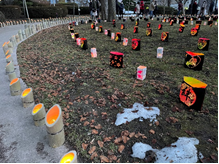Thirteen years after Great East Japan Earthquake, Fukushima nuclear accident Message from Iwate Jichiroren
Thirteen years after Great East Japan Earthquake, Fukushima nuclear accident
Message from Iwate Jichiroren
The Great East Japan Earthquake on March 11, 2011, caused tremendous damage and claimed many lives. There were 15,600 deaths, 2,520 people missing, and 3,802 disaster-related deaths (according to the National Police Agency). Even today, 29,328 people are still evacuated nationwide (according to the Reconstruction Agency). The accident at the Fukushima Daiichi Nuclear Power Plant, operated by the Tokyo Electric Power Company (TEPCO), has yet to be brought under control.
This year, a magnitude 6.9 earthquake struck the Noto Peninsula in Ishikawa Prefecture on New Year’s Day. The question is whether lessons from the 1995 Great Hanshin-Awaji Earthquake and the Great East Japan Earthquake have been learned as well as whether the national government has seriously lacked awareness of crisis management. The following are excerpts of a message from Iwate Jichiroren in Iwate Prefecture, where nearly 5,800 residents have died or been missing in the Great East Japan Earthquake (from articles published in its organ paper).
Iwate Jichiroren:
Lights for Prayer to never forget the disaster
This March marks the 13th year since the Great East Japan Earthquake, and next year will mark the 30th anniversary since the Great Hanshin-Awaji Earthquake. We have to reiterate that lives that survived or were saved from the earthquakes and subsequent tsunamis should not be lost in the following evacuation process.
An event to commemorate the 13th anniversary of the Great East Japan Earthquake, “Lights for Prayer 2024 – the Day to Pass down the Memory,” was held on March 11 at a square in front of the Morioka History and Culture Museum. The Lights for Prayer event has taken place every year since 2012 to pray for the repose of the souls of the earthquake victims and hope for the recovery of the disaster-hit areas. Handmade garden lanterns were laid out in the square, and a lighting ceremony was held at 5:00 p.m. As the lanterns were lit, a variety of messages drawn on which got illuminated, and participants gave their thoughts to the affected areas along the coast.
Poor conditions of shelters unchanged, Noto Peninsula quake
In the quake-stricken area of the Noto Peninsula, evacuees had only one thin blanket provided on a cold floor in the midwinter weather. They said that the shelter was too cold to get out of futons and move their bodies, and that they were exhausted in cramped shelters. These show clearly how harsh it is to live in shelters.
That those who had survived the earthquake had to die at evacuation centers set up by local administrations under the law, is a fact calls the responsibility of politics into serious question. Earthquakes and tsunamis is an unavoidable event that naturally occurs, so national and local governments are responsible for minimizing damage caused by them. The loss of lives during evacuation or due to poor living conditions in shelters must be prevented at any cost. The national government should drastically improve its support for affected residents so that they can find hopes.
